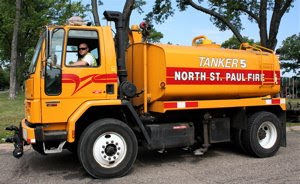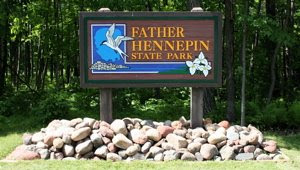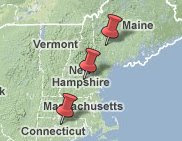Though I like cities for the change of pace, my nerves almost always get overstimulated. The previous night's downtown reading and this day's interview with All Things Considered on Minnesota Public Radio required navigating downtown freeways on unfamiliar exits. This woke me up far too early, something would pay for it later that night when I couldn't tell one road from another on my map.
Having heard Maggie and Haley’s story about Silver Lake the night before, I walked down to see it as soon as I got the chance. What could it be, I asked myself, that could kill a species of fish that are fairly resistant to environmental insult?
Urban Lake
Of course, I don’t know what killed the fish on Silver Lake in North Saint Paul. Perhaps nobody does. But Ingrid has an idea. She recalls as summer day when the kids were playing at the swimming beach and the moms were visiting while monitoring their broods. This was what I saw a week before at Walden Pond, with one exception, the mom’s were not talking. Then all of a sudden, Ingrid watched a boat across the way that was about 30 yards from shore, spraying the water with pressurized nozzles. First they got the kids out, and then they went over for a closer look. It was a lawn care company who had been hired by someone on the opposite shore that decided to spray the lake as well.
Were not the timing of the fish kill the kids saw, I would have suspected a phenomenon called “winter kill,” caused by the loss of oxygen beneath the ice. I soon found another set of clues to a potential killer.
Between the road and the lake were: a corroded cement culvert; a notch in the compact soil around the lake bracketed by a luxurious growth of grass; an abandoned channel cut below and into the small beach; a submerged delta composed of pebbles the size of walnuts; a veneer of organic flotsam and mud on the delta plain; and a truncation of the front of the delta sheared off by waves.
Storm drain entering Silver Lake, North Saint Paul, Minnesota. Not a good idea.
To a geologist, this is proof positive for the following sequence of events. Ambient conditions were followed by a heavy rush of runoff from the rooftops, driveways, patios, and streets that was captured by city drains and conveyed directly to the lake. This was followed by a rise in the water level accompanied by strong wave action. Arriving with that runoff were invisible residues of fertilized lawns, pet poop, the oil spots in the driveways, and much scarier stuff dumped furtively in backyards. All this was thoroughly mixed into the lake by density flows and a vigorous circulation set up by shoreline currents set up by waves.
But what was it that washed into the lake? Was it the chemicals washed off the nice lawns? I suspect that the main problem with the storm runoff was a surge of nutrient; possibly from an overloaded and leaky sewer system Plugging leaks would not solve the problem of waterfowl feces, a problem made much worse by the feeding of geese, ducks, and gulls as if they were pets.
City of Saint Paul Fire Department. That was the label on the water truck in the park. But the person operating it, a twenty-something named Jason, was far too relaxed to be a fireman on duty. Instead, he was an employee of the city’s public works department, spending the morning watering the saplings of recently planted trees.
Jason is all set to water trees in North Saint Paul, Minnesota.
He was happy to answer my open-ended questions about the highs and lows of freshwater. His responses were as classic as they were revealing.
“The tap water is pretty good,” he said in response to my prompting that he identify something positive. “No complaints.” On the down side he said, “This was an older community.” What he meant was that the water control infrastructure is outdated. Indeed, municipalities are now doing what they can to replace half-century old sewer systems, which are often full of leaks.
Old sewer infrastructure is a problem for many cities wishing to improve their water quality. This one is from Silver Lake area, North Saint Paul, Minnesota.
They are also trying to re-route storm water drainage away from standing bodies of water, to which it was conveniently directed before the crescendo of environmental concerns during the decade between 1965 and 1975, when the National Environmental Policy Act (created the EPA) of 1970, the Clean Water Act of 1972 (actually the amendments), the Clean Air Act, the Hazardous Waste Act, and countless others shifted the nations attention in that direction.
Many rural sewage plants are tiny, but effective. Isle, Minnesota.
The most revealing part of Jason’s responses was how biased they were. Not in a bad way, but in a focused way. He works for Public Works. Hence, his responses are about public works: the quality of city water and the aging infrastructure for managing it.
Lake Calhoun
Getting to the urban park required major map work, merges, stoplights, and quick turns. People were everywhere, jogging, biking, walking, and sailing. Not one person was swimming, even on a nice July day
While waiting for Jeff Jones, the producer, I noticed that the edge of Lake Calhoun had been tractor raked of what looked like milfoil.
Edge of Lake Calhoun in Minneapolis, Minnesota, cleared of aquatic macrophytes (milfoil ?) with a tractor-drawn rake.
Milfoil is an amazing plant. And a scary one too; an invader from another world.
Generally speaking, invasive plants, both on land and in the water, are the Dunkin Donuts of the plant world. There’s nothing toxic about them. Botanically, they’re fascinating. Many are beautiful, especially purple loosestrife, which is so pretty it was sold as a garden perennial. What makes invasive plants a problem is that they simply does a better job than most native plants in doing what a plant is supposed to do: getting nutrient, sunlight, and habitat space. In the human world, Dunkin Donuts gets most of the donut money, the most strategic spaces at the mall, and a steady stream of customers in search of the holy trinity of junk food: white flour, sucrose, and oil. Our bodies crave the trinity. Then it kills us slowly with obesity-related illnesses.
What makes floating aquatic plants like milfoil especially troublesome is that, during windstorms, they wash up on shore in great heaps where they block access and slowly rot to produce those fishy, sulfurous smells. That’s why the tractor-driven rake came by.
At 11:00 sharp the producer for Minnesota Public Radio, Jeff Jones, and the host Tom Crann, showed up for an interview for All Things Considered. It was broadcast on Friday, July 10 at 4:50 PM Central Time, and is still online, using the link to on Minnesota Public Radio .
Heading North
The Twin Cities exist because of the Mississippi River. Heading north, it get smaller and smaller until its source at Itasca Lake. We began to track this downsizing, beginning in Anoka.
Mississippi River near Akoka, Minnesota.
There, invasive species were an issue for the river, as well as isolated lakes.
Warning signs about invasive species at the Mississippi River in Anoka, Minnesota.
Further north, the City of Ramsey, Minnesota is new, or at least the vast majority of its domiciles are. I use the word domicile because I’m never sure what to call these structures flanking both sides of Route 47 heading toward Mille Lacs. What should I call them? Apartments? Townhouses? Condos? The look less like Levittown houses and more like the hives of oversized bees.
Ramsey, my blogging partner informed me, feels like the true edge of the Twin Cities metropolitan area. Here, where old meets new, is when she begins to feel comfortable again. In this case, “old” refers to the typical rural countryside reflective of land use patterns of the first half of the 20th century, before suburbs were king. “New” refers to the outward-spreading edge of a 21st century bedroom communities.
Indeed, the metabolic needs of humans haven’t changed. We’re still nearly three-fourths water by weight. Without water, we are metabolically dead. Hence, I’m sure water towers will be with us forever. The nearby town of St. Francis provided an easy chance to photograph one of these new towers.
Water tower in St. Francis, Minnesota
I caught the Fed Ex truck speeding by on purpose to capture the urgency of modern life. I contrast it with the old fashioned style below, which is the most common I've seen.
Water tower for Isle, Minnesota.
Mille Lacs
We pulled into Father Hennepin State Park to photograph the largest lake in Eastern Minnesota.
Father Hennepin State Park, Isle, Minnesota.
This early explorer was the first to describe St. Anthony Falls, in present-day Minneapolis, Minnesota. This is the largest waterfall west of Niagara Falls, which Father Hennepin was also the first European to describe.
Nancy, the attendant at the gate, enjoyed fresh water for its swimming. She couldn’t think of a concern.Mille Lacs is the name of a single large lake, but the translation from French means “thousand lakes.” This, we learned from the brass plaque on the boulder monument in Garrison. This is a remnant of a large ice-front lake, meaning it is fairly shallow and therefore very fertile in fish. I believe it is the most important destination lake for the Twin Cities Metro area.
Mille Lacs, looking North from Father Hennepin State Park, Isle, Minnesota.
This western shore of Mille Lac Lake is where another Frenchman, a voyageur named Sier Du Lut (for whom Duluth was named), discovered many Sioux villages along the western shore. The Sioux were later driven out by the Ojibwe, who were migrating in from the east, having been displaced by other tribes. Here we encountered a beautiful new statue of the most sought after game fish, the walleyed pike, or walleye for short.
Walleye statue in Garrison, Minnesota.
A.J. is a member of the Mille Lacs band of the Ojibwe who works at the Indian Museum in Kathio, Minnesota. On nice summer weekends, he said, there are as many as 14,000 anglers on Mille Lacs Lake, nearly all of who drive up from the Twin Cities to fish for walleye. That number struck me as so high that I though A.J. had added an extra decimal place. Even 1,400 anglers on a single Minnesota lake would be astonishing, if only for the gasoline it takes to get their boats and trailers here from the suburbs, and power the boats out to their secret fishing places.
Apparently, 400,000 pounds of fish are taken from this lake each year, practically all of that weight being from one species, the walleye. I couldn’t resist doing a calculation. If 14,000 fishermen fished for ten good summer days, that would be 140,000 man-days of fishing. Each of those days would have produced less than three pounds of whole fish per day, which translates to less that two pounds of fillets per trip per man. That’s mighty good eating. But just think of the poundage of carbon dioxide sent up into the air in search that experience. Is it worth it? Locally? Certainly. Globally, I’m not so sure.
A.J.’s main concern was about the rights of indigenous peoples the “white people.” He explained that many Minnesotan’s are disgruntled with recent federal laws that give the Native Americans special hunting and fishing privileges that are free of taxation.
Leaving Garrison, we headed north through Deerwood, where my twin brother lives. He was at work, so we didn’t stop by. Next was the uneventful town of Crosby, furthest south of the old iron mining towns in Minnesota. Seeing the old mining museum got me to thinking about or first encounter with big scale mining in Iron Mountain, Michigan, two days before.
We crossed the Mississippi at Aitkin. At this point, it’s a typical river in every way except for its excessively winding habit.
Mississippi River from the bridge on County Road 1 in Aitkin, Minnesota.
It's running mostly greenish brown at this point, due mostly to a mixture of tea-stained water from organic materials, and green from algae.
Hackensack
Paul Bunyan’s wife dominates the waterfront of Hackensack, Minnesota and may have dominated him as well. After all, her statue is three times larger than his. She is featured, he is not.
Statue of Paul Bunyan’s wife, Lucette, from Hackensack, Minnesota.
Hackensack is alleged to be the town of her birth; it’s also a quirky, and completely fascinating place. Inside the general store are all kinds of north-woods and lake-related items. My favorite, was a candle stand made of a simulated fishing lure.
Candle stand in Hackensack General Store, Hackensack, Minnesota.
When I put the water questions to the cashier and sole employee, Wendy said the biggest problem with water around here is that she ran out of bottled water for her “pop cooler.” When a Minnesotan says, “pop,” a New Englander in the same circumstance would say “soda.” Visitors to the store keep coming in for water, but have to leave the store without it. I’m glad that water is in such demand. It’s certainly better for you than soda pop, which is the full name. Apparently New England got the first half of the name, “soda,” whereas the Upper Midwest got the second half, “pop.”
Her other concern involved aquatic plants. “I hate the water lilies because they always get stuck in the propeller.” Closer to the truth is the fact that they do much to sop up phosphorous that would otherwise make the lake murky and provide critical habitat for many creatures.
On the plus side, Wendy was glad to live in Hackensack because it lies in the heart of Minnesota lake country. Attitude is everything. Some of the folks I know back east would consider this a “hick,” town, not a “hack,” one. They would be wrong.
As I was leaving town, I walked over to photograph the water tower, below which a little league baseball game was being played. On the way, I saw a sign posted in a window, advertising the price to lease a building. It was forty-two cents per square foot per month. That may sound low to most readers, but I suspect it sound like zero to my son who works in real estate finance and leasing.
It being late, we made no further stops before Lake Plantagenet, where my parents have a family cabin.

















